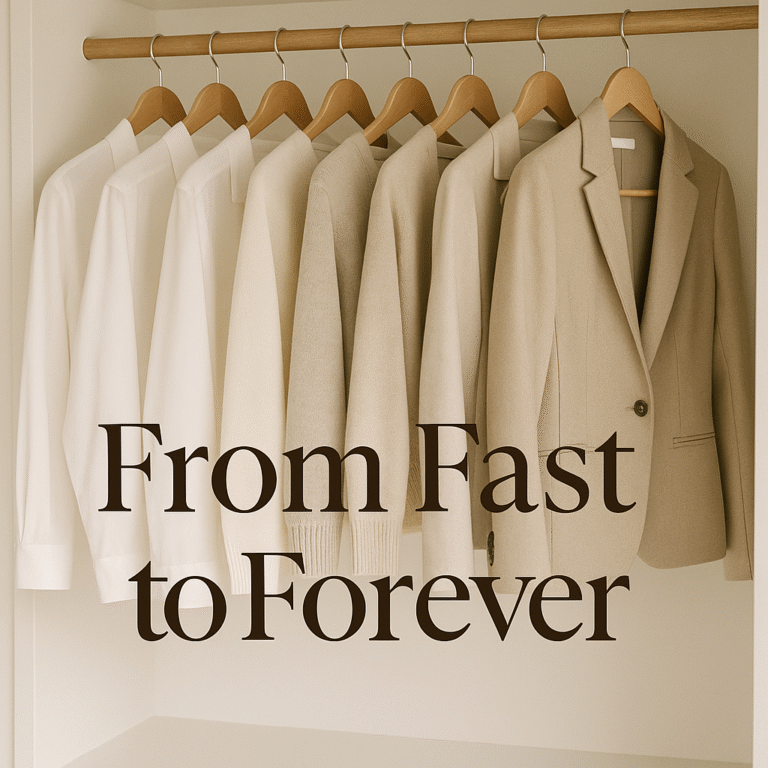Your cart is currently empty!
The fashion industry’s environmental impact has reached a tipping point, with fast fashion contributing to massive waste and unethical labor practices. Yet many consumers believe that building a sustainable wardrobe requires a hefty investment that’s simply out of reach.
The truth is, transitioning from fast fashion to a forever wardrobe doesn’t have to drain your bank account. With strategic planning, creative thinking, and conscious decision-making, you can build an ethical, eco-friendly closet that reflects your values while staying within budget.
This guide reveals ten practical strategies to transform your fashion choices without financial strain.
Start with Your Current Closet: Assessing What You Already Own
Before spending a single dollar on new sustainable fashion brands, take inventory of what you already own. This foundational step in conscious consumerism fashion can save hundreds of dollars while reducing fashion waste.
Empty your entire wardrobe and categorize items into three piles: love and wear regularly, occasionally wear, and never wear. The “never wear” pile often contains hidden gems perfect for upcycling old clothes ideas. That forgotten dress might become a trendy top, while outdated jeans could transform into stylish shorts.
Check fabric labels to identify eco-friendly fabrics and materials you already own. Natural fibers like cotton, wool, and linen align with zero waste fashion practices and typically age better than synthetic alternatives.
Calculate the cost-per-wear of your favorite pieces. Items worn 50+ times prove that quality investments pay off—a core principle of the slow fashion movement benefits. This exercise reveals your personal style preferences and helps identify gaps that truly need filling, creating your personalized sustainable fashion budget guide for future purchases.
Smart Shopping: Finding Affordable Sustainable Fashion Brands and Ethical Clothing Options
Finding affordable sustainable fashion brands requires strategic research and timing. Start by identifying ethical clothing options that align with your budget through end-of-season sales, outlet sections, and subscription newsletters that alert you to discounts. Many fair trade fashion brands offer student discounts or first-time buyer promotions.
Focus on brands that prioritize eco-friendly fabrics and materials like organic cotton, Tencel, or recycled polyester, which often provide better value through durability. Consider direct-to-consumer sustainable fashion brands that cut out middleman costs, making ethical pieces more accessible.
Conscious consumerism fashion means calculating cost-per-wear rather than upfront price. A $60 ethically-made shirt worn 50 times costs $1.20 per wear, while a $15 fast fashion piece worn 5 times costs $3 per wear.
Create a sustainable fashion budget guide by setting aside money monthly for planned purchases. Sign up for brand newsletters, follow sales calendars, and consider buying previous season items when sustainable brands clear inventory. This approach makes ethical fashion financially sustainable.
Creative Upcycling Projects: Transforming Old Clothes into Fresh Wardrobe Pieces
Upcycling old clothes ideas offer endless possibilities for refreshing your wardrobe while practicing zero waste fashion practices. Transform oversized shirts into trendy crop tops or fashion statement sleeves by cutting and hemming. Convert worn jeans into stylish shorts, tote bags, or patchwork skirts using basic sewing techniques.
Simple modifications like adding patches, embroidery, or fabric paint can completely reinvent tired pieces. Turn old t-shirts into tank tops, headbands, or cleaning rags. Combine different garments to create unique layered looks or mix patterns for contemporary styles.

These reducing fashion waste tips align perfectly with the slow fashion movement benefits, extending garment lifecycles while developing creative skills. Upcycling costs significantly less than purchasing new items, making it an ideal sustainable fashion budget guide strategy.
Online tutorials and local workshops provide inspiration and instruction for various skill levels. By reimagining existing pieces, you participate in conscious consumerism fashion while building a personalized wardrobe that reflects your individual style and environmental values.
Understanding Eco-Friendly Fabrics and Materials That Fit Your Budget
Choosing eco-friendly fabrics and materials doesn’t mean compromising your budget. Understanding which sustainable options provide the best value helps you make informed decisions when building your ethical wardrobe.
Organic cotton, while slightly more expensive than conventional cotton, offers durability that justifies the price difference. Linen and hemp are affordable natural fibers that improve with age and washing. Tencel and modal, made from sustainably sourced wood pulp, provide luxury feel at moderate prices.
Many sustainable fashion brands now offer budget-friendly lines featuring these eco-friendly fabrics and materials. Look for end-of-season sales, outlet sections, and direct-to-consumer brands that eliminate retail markups. Bamboo fabric presents another cost-effective option, naturally antibacterial and incredibly soft.
Avoid synthetic blends that shed microplastics and won’t last. Instead, invest in pure natural fibers that age gracefully. Check garment labels carefully – some “eco-friendly” claims are misleading. Focus on certifications like GOTS (Global Organic Textile Standard) or OEKO-TEX, which guarantee authentic sustainable materials without inflated prices.
Thrift Store Success: How to Shop Secondhand for Quality Sustainable Pieces
Thrift shopping is a cornerstone of any sustainable fashion budget guide, offering incredible finds at fraction-of-retail prices. Start by visiting thrift stores in affluent neighborhoods where you’re more likely to find high-quality pieces from sustainable fashion brands and ethical clothing options that were donated in excellent condition.
Before heading out, research eco-friendly fabrics and materials to identify quality items. Look for natural fibers like wool, cotton, linen, and silk that age gracefully. Check seams, zippers, and buttons for durability—these details separate lasting pieces from fast fashion castoffs.
Timing matters significantly. Shop weekday mornings for the best selection, and visit regularly since inventory changes constantly. Don’t overlook items with minor flaws; they’re perfect candidates for upcycling old clothes ideas that can transform them into unique wardrobe staples.
This approach to conscious consumerism fashion directly supports reducing fashion waste tips while building a versatile closet. Each secondhand purchase prevents clothing from entering landfills while offering you authentic pieces that align with zero waste fashion practices without compromising your budget.
Adopting Slow Fashion Movement Benefits for Long-Term Savings
The slow fashion movement benefits extend far beyond environmental consciousness – they create substantial long-term savings for your wallet. By shifting from frequent impulse purchases to intentional buying decisions, you’ll dramatically reduce your annual clothing expenses while building a higher-quality wardrobe.
Sustainable fashion brands may have higher upfront costs, but their superior construction and timeless designs mean garments last years longer than fast fashion alternatives. A $80 ethically-made shirt worn 100 times costs less per wear than a $20 shirt that falls apart after 10 wears.
This conscious consumerism fashion approach encourages buying fewer, better pieces made from eco-friendly fabrics and materials that maintain their shape and color over time. Quality garments from fair trade fashion brands often come with repair services and warranties, further extending their lifespan.
The slow fashion mindset also promotes reducing fashion waste tips like proper garment care, seasonal storage, and strategic wardrobe planning. These practices maximize your existing investment while minimizing the need for constant replacements, creating a sustainable fashion budget guide that actually saves money.
Practical Tips for Reducing Fashion Waste and Extending Garment Life
Extending garment life is one of the most effective reducing fashion waste tips that costs nothing but saves everything. Start with proper care fundamentals: wash clothes in cold water, air dry when possible, and store garments correctly to prevent stretching and fading. Learn basic mending skills like sewing buttons, patching holes, and hemming pants – these simple repairs can add years to your clothing’s lifespan.
Implement zero waste fashion practices by rotating your wardrobe seasonally and treating stains immediately. Invest in quality hangers and cedar blocks to maintain garment shape and prevent moth damage. When pieces become worn, consider upcycling old clothes ideas: transform damaged jeans into shorts, turn oversized shirts into crop tops, or repurpose fabric for household items.
Conscious consumerism fashion means viewing each piece as a long-term investment. Regular maintenance like steaming wrinkled items instead of frequent washing, using fabric shavers to remove pilling, and professional cleaning for delicate pieces will maximize your wardrobe’s value while supporting sustainable practices.
Building a Capsule Wardrobe: Zero Waste Fashion Practices on a Budget
A capsule wardrobe represents the ultimate zero waste fashion practices approach, focusing on 20-30 versatile pieces that mix and match seamlessly. This sustainable fashion budget guide strategy significantly reduces clothing waste while maximizing outfit possibilities from minimal items.
Start by selecting a neutral color palette—black, white, gray, navy, and one accent color. Choose quality basics like well-fitted jeans, classic blazers, white button-downs, and little black dresses that work across seasons. These ethical clothing options should be purchased strategically, one piece at a time, allowing you to invest in better quality without overwhelming your budget.
The slow fashion movement benefits shine through capsule wardrobes as each piece gets worn frequently, justifying its cost per wear. Focus on eco-friendly fabrics and materials like organic cotton, linen, and wool that age beautifully. Support fair trade fashion brands when possible, or incorporate upcycling old clothes ideas to create unique capsule pieces. This conscious consumerism fashion approach reduces impulse purchases while creating a cohesive, functional wardrobe that serves your lifestyle efficiently.
Your Path to Conscious Fashion: Making Sustainable Choices That Last
Transitioning to conscious consumerism fashion requires a fundamental shift in how you approach clothing purchases and wardrobe management. Start by developing a personal sustainability framework that aligns with your values and budget constraints. Prioritize quality over quantity, choosing versatile pieces from sustainable fashion brands that can be mixed and matched across seasons.
Create a long-term purchasing plan that incorporates ethical clothing options and fair trade fashion brands when budget allows. Between major purchases, focus on reducing fashion waste tips like proper garment care, repairs, and storage. Implement zero waste fashion practices by repurposing items that no longer fit your style through creative alterations or swaps with friends.
The slow fashion movement benefits extend beyond environmental impact—investing in durable pieces reduces per-wear costs over time. Track your cost-per-wear for each item to make informed decisions. Remember, building a sustainable wardrobe is a gradual process that combines mindful shopping, creative upcycling old clothes ideas, and choosing eco-friendly fabrics and materials that stand the test of time.
Powered by Azon AutoSites
Related Posts

Technical Analysis: 4 Stocks with signs of death crossovers to keep an eye on

HDFC Bank & 3 other fundamentally strong stocks trading above 200 DMA to keep an eye on

Falling Channel Breakout: Multibagger NBFC Stock Shows Bullish Momentum on Daily Chart

4 Fundamentally strong stocks to buy for an upside potential of up to 36%; Do you hold any?


Leave a Reply